The Gardens (Court Gardens, Gardener's Cottage)

Where Court Gardens cottage can now be found was numbered Plot No 202 on the 1806 Inclosure Act plan and was then an orchard owned by Edward Webb of the Norton Court Estate. Plot No 201 was already gardens but there were no buildings on either plot.
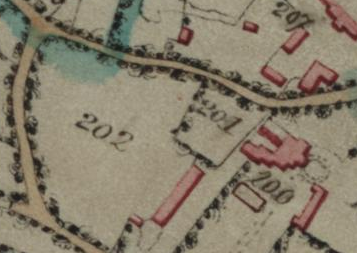
In 1847 Norton Court house was extended to provide a morning room and extra service accommodation; perhaps this was when the gardeners cottage and coach house were built.
In May 1848, at the second exhibition of Gloucester Horticultural Society held at the Spa, Mr Smith, gardener to Miss E Webb of Norton Court, came second in the best six greenhouse plants competition. Perhaps Mr Smith was the first incumbent of the cottage ? This is likely the case as in 1851 there was both a Gardener’s House and a Coach House, and when Norton Court sold in 1867 it was said to have “coach houses and stabling, gardener’s and coachman’s cottages”. These cottages appear on the 1st Edition, OS 25” map along with greenhouses and a formally laid out garden.
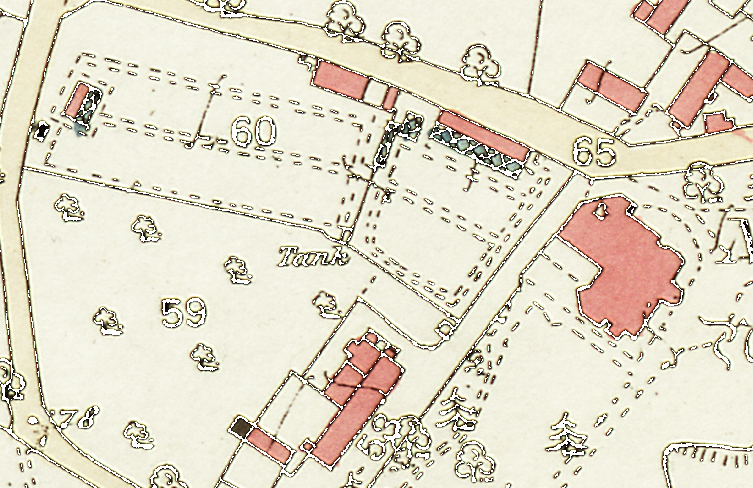
1st Edition, OS 25” map, 1844-1888
John Smith was born at Shirburn, Oxfordshire, on 31 October 1796, the son of William Smith and Olive nee Springall. Growing up at Shirburn, John married Mary Ann Whichelow, who was from the nearby village of Tetsworth, on 14 February 1824, in Lewknor. They appear to have had ten children; Hannah, William, Abiel, Mary Ann, John, Susannah, Samuel, Esther, Georgiana Elizabeth and Ann. John took up the profession of gardener, later head gardener, and worked in at least two and possibly four large houses in Gloucestershire and Oxfordshire. In 1841 John is recorded as the gardener at Adwell House, Adwell, Oxfordshire.
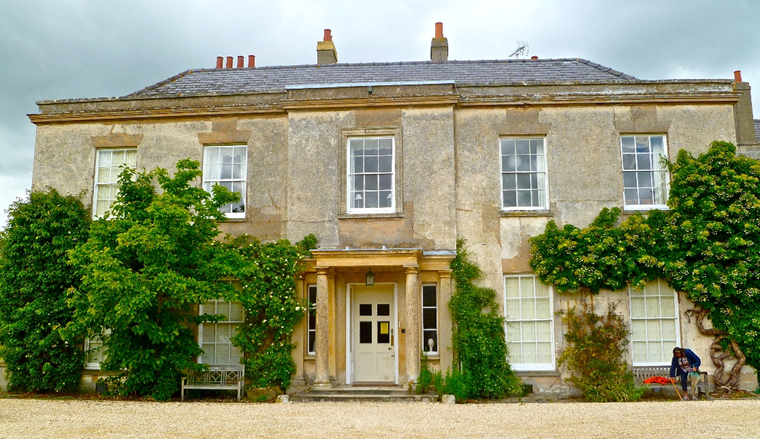
Adwell House
It is likely due to the connection with Adwell that John got the job at Norton Court with Adwell being one of the homes of Edward Webb whose family were still here at Norton Court at this time.
In 1851 there were at least two gardeners living on the Norton Court Estate. John Smith, his wife Mary, and three young daughters; Esther, Georgina and Ann were living in the Gardener’s House. The other gardener, living nearby in the Coach House, was George Fisher, his wife Elizabeth and daughter Emily who had been born at Norton the previous year.
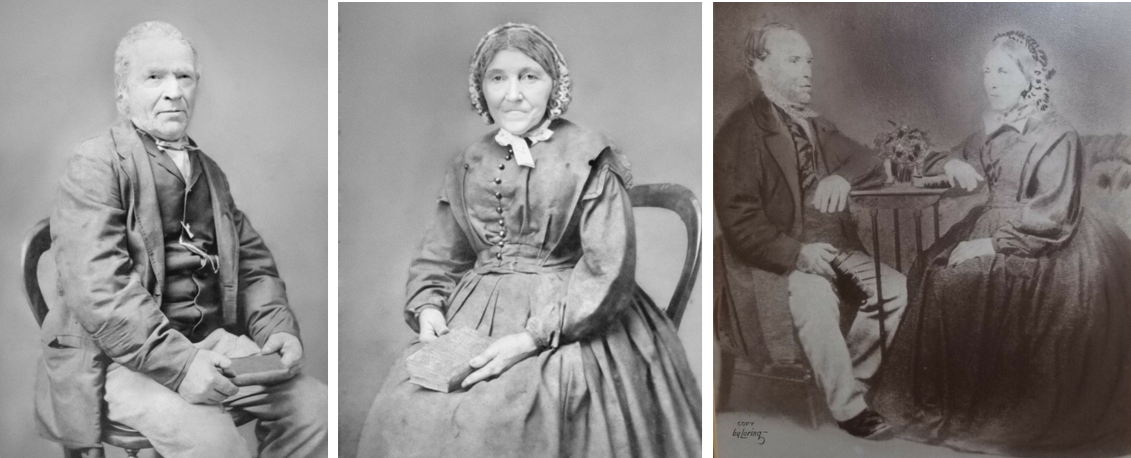
John & Mary Smith
John’s son William, born at Adwell in 1824, married Mary Ann Townsend of Norton at Tewkesbury Abbey in 1851 and had four children baptised at Norton before leaving for Edgeworth in the later 1850s. Throughout his time at Norton William was also employed as a gardener and perhaps worked with his father at Norton Court. It is not known where at Norton they lived.
It is not clear exactly when John left Norton, likely late 1850s the same time as his son William, but by 1861 he was living at Longlevens and by 1871 he was at Twigworth still employed as a gardener. John Smith died on 7 April and was buried in a grave to the rear of Twigworth Church on 12 April 1876.
I visited Twigworth church in October 2024 and, although it is very difficult to read now, and was covered in fallen leaves when I got there, I found John and Mary’s grave.
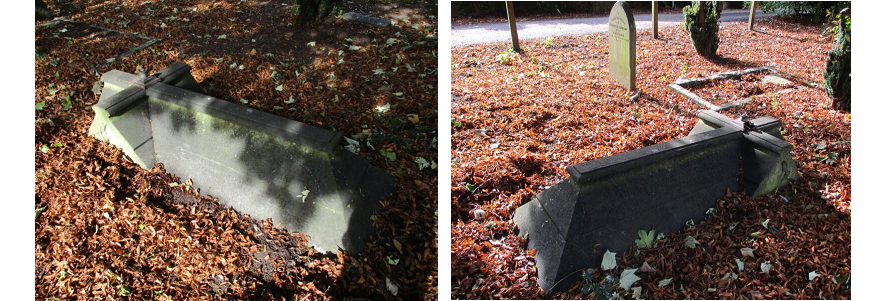
[John and Mary’s daughter Esther married a Norton resident and chairmaker, Henry Bouskill, at Norton in 1861, and one of their daughters was Mary Ann (“Polly”), who went on to marry into the Cambridge family of Gloucester. She was the great-grandmother of Craig Patterson who has helped us with information about John and his family].
There are no likely candidates for the Norton Court gardener in 1861 but in the 1871 the census identifies William Bennett, a 45 year old gardener from Stroud living at an address vaguely recorded as ‘The Lane’ but in the right part of the village for him to have been at Norton Court. He was living with his wife Charlotte and six children, the eldest of which, George, was also employed as a gardener. The ages and places of birth of the children suggest that the family arrived here in 1862/63 with a baptism at Norton of son Albert recorded in February 1863. In 1861 the Bennetts had been living at Haywar End, Stonehouse, with father William employed as a labourer so gardening professionally was new to him. In 1881, having left Norton, the family are living at Richmond Buildings, Stroud, with William still employed as a non-domestic gardener employment he remains in throughout his life.
An undated document that appears to date from approximately 1860 records the particulars of the Norton Court Estate, then in the occupation of James Goodrich. At the time this plot of land was listed as No 64 and was described as "kitchen gardens, piggery, gardener's cottage and laundry" and was 1 acre, 38 perches, in size.
In 1881 the Gardener’s House must have been short of space with John Jordan, a 32 year old from Barnwood, his wife Esther and six children, the youngest of which, Ada, had been born at Norton the previous year and baptised here in September 1880 indicating when they arrived in the village. John’s mother in law Ann Ravenhill, and two nieces, were also living here and George Williams, an under gardener, was lodging with them. In 1871 John was still single and living with his parents at Barnwood but was already employed as a gardener. Interestingly, John’s mother was Elizabeth nee Marston who had been born at Norton in 1819 and John’s maternal grandfather had only just died at Norton in 1873. In 1891 and 1901 John and his family were living at Horton Road, Gloucester, with John still employed as a gardener and, in 1901, one son, Eli, employed as an under gardener. Around this time Charles Betteridge Walker, who owned Norton Court, had been living at Wotton House, in Horton Road, so it is possible that John Jordan continued to work for him. Charles Walker was also a director of Messrs Price, Walker, & Co, timber merchants, and in 1901 another of John Jordan’s sons, James, was employed as a sawyer at a timber mill. By 1911 the Jordans had all moved to Waltham Lodge Cottage, Westbury on Trym, Bristol, where both John and Eli were still employed as gardeners.
In 1889 William Cross was in residence at the Gardeners Cottage near Norton Court.
In 1891 William Martin a 33 year old gardener and domestic servant from Scotland was at Norton’s Gardener’s Cottage with his wife Agnes and young son, both also from Scotland. John Wilson, a gardener and domestic servant from the Isle of Wight was also lodging here in the Gardener’s Cottage. In 1901 James, wife and son had moved to Ozleworth, Glos, where he was still employed as a gardener as was his son.
In 1896-1900 James Mullens was head gardener and living here. [I have to profess a personal interest here as James was my great grandfather]. James was born on 13 February 1868 at Charlton, Wilts, son of William and Eliza Mullens. By 1891 James had left Wiltshire and was lodging with William Ward, farmer, and his wife Ellen, at Honington, Shipston, Warwickshire, employed as a gardener. By 1893 James had moved again and was employed as a gardener, living at Blenheim House, Stretton Sugwas, Herefordshire. James married Fanny Stubbs, daughter of Henry Stubbs, at St Mary’s, Norton, on 17 June 1893. In 1881 Fanny had been working as a domestic nurse for Thomas Watts, a General Practitioner, of Denhalls, Saul, where she was also living but by 1891 she had returned to live with her parents and was working as a laundress at The Post Office, Norton, which later became Green Corners.
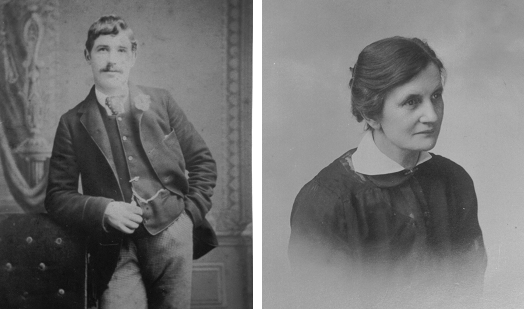
James Mullens Fanny nee Stubbs
After their marriage Fanny moved to live with James at Blenheim House, Stretton Sugwas, and it was here on 9 December 1894 that their first child; Frances Edith, was born. Frances Edith was baptised at St Mary’s, Norton, so the ties to Fanny’s home were being kept and by the time their second child, Frederick George, arrived on 22 May 1896, the couple had returned to live at Norton. James obtained a job as head gardener at Norton Court and they lived at ‘The Gardens’, the property allotted to the head gardener in the grounds at the rear of the Court. The house where James and Fanny lived has a walled garden in which the produce for use at the Court was grown. In November 1896 Col Arbuthnot, the Court’s tenant, won first prize for two bunches of white grapes and second prize for two bunches of black grapes at the Gloucestershire Root, Fruit and Grain Show. It is interesting to note that it was Col Arbuthnot who won the prize and it was recorded as an afterthought that James was the actual gardener. [In 2000, I was told that there was an old grape vine still in a greenhouse at The Gardens tagged with the name ‘J Mullens’ but I never got to see it]. Due to his position at Norton Court James got seconded for all sorts of duties such as decorating the church of St Mary’s for Easter services, the following in 1897; “The church was, as usual, brightly decorated for the Easter Festival. Mrs and Miss Arbuthnot [Norton Court], assisted by the head gardener (J Mullens), took charge of the chancel. The chancel windows were tastefully filled with pots of spirea, cineraria, and deutchis, the east window having in the centre a floral cross. A coraice of white and red flowers formed the base upon which stood the bases and cross above the table, while the communion rails were wreathed with ivy, intermingled with flowers and fruit blossoms”.
Christmas 1897 saw James in action at St Mary’s again; “The church was very tastefully decorated in accordance with the Christmas season. The chancel arch and two side windows of the nave were wreathed with evergreen, the deep sills of the widnows being filled with chrysanthemums in pots embedded in evergreens. The re-table had four vases of flowers, arum lillies, primulas, narcissus, and Roman hyacinth. The choir stalls were ornamented with cut chrysanthamums and holly, the east window with flowers in pots, yew and holly. This part of the work was ably done by Mr James Mullens, the gardener at Norton Court, and his assistants”. In July 1898, again due to his position as ‘head gardener of Norton Court’, James was a judge at the St Mary De Lode Flower and Industrial Show, at Kingsholm rugby ground, Gloucester. This must have resulted in more such appointments and one I have found was in August 1900 when he was judge at Upton St Leonards Horticultural Society annual show at Bowden Hall.
As well as his gardening duties at Norton Court, James involved himself in various village affairs and clubs. In 1897 James was secretary to the Norton and Sandhurst Cricket Club for whom he also played. He was Secretary of Court Wainlode, No 6601, Ancient Order of Foresters, and on 14 April 1898 he answered roll call for Norton at the half-yearly meeting of the AOF Gloucester District at Foresters Hall, Gloucester. James had also become involved with the Parish Council during his short time in the village, seconding the nomination of two Councillors in 1901.
It is not clear why James ceased to live at The Gardens but presumably he lost his job at Norton Court for some reason, perhaps sickness as he was suffering with diabetes, but by 1901 the family were living at the Post Office, later to be Green Corners, Norton, with Fanny’s widowed father, Henry Stubbs. At this time James gave his occupation as a seedsman traveller and he appears to have been employed by J C Wheeler & Son, Ltd, who had a seed store at 99 Northgate Street, Gloucester, and an ornamental nursery in the Worcester Street, Alvin Street, area of Gloucester. In November 1901 James won a prize for chrysanthemums at the Gloucestershire Root, Fruit and Grain Society show and gave his employer as Messrs Wheeler & Son Ltd. James also won when he showed chrysanthemums at the same show in November 1902.
Later in 1901 James appears to have found work as a gardener at Tuffley, and moved to live at 6 May Hill Villas, Whaddon. In 1901 G. T. Whitfield built Fox Elms at Tuffley as his residence and many smaller houses for employees at the brickworks that he opened on Robinswood Hill in the early 1890s. May Hill Villas consisted of four pairs of dwellings on the main Stroud Road (A4173) and were built in 1896 or 1897 as part of that development. It seems quite possible, therefore, that James had been employed as a gardener at Fox Elms at this time. On 5 February 1904 James slipped into a coma as a result of his diabetes and he died without regaining consciousness on 7 February. He was brought back to Norton and was buried at St Mary’s on 11 February. Fanny was left a widow with four young children to support and she returned to live with her father at Green Corners.
In 1901 the Gardener’s Cottage was occupied by James John Leat, known as John, a 42 year old head gardener from Rowhams, Hants, his wife Rose and 2 year old daughter Elsie Mary. Elsie had been born before he arrived at Norton suggesting he didnt start employment here before 1899. In February 1904, Dorothy Gerturde Arbuthnot, daughter of Col George Arbuthnot of Norton Court, married at Gloucester Cathedral, and it was noted that her bouquet was made by Mr Leat, the gardener at Norton Court. In 1911 the family had returned to Hampshire and were living at Fawley, near Southampton, with John still employed as a gardener.
In 1907 another of Col Arbuthnot's daughters, Molly, married at St Mary's, Norton, and it was recorded that the church decorations were the work of Mr Phipps, gardener at Norton Court. In 1901 Charles Phipps was living with his family at Sandhurst employed as a gardener. Charles was born in 1866 at Sandfield, Warks, son of Charles, a shepherd, and Ann Phipps. He married Annie Bertha Gabb at Shipston, Warks, in 1895, and had several children including Cecily Janet who was baptised at Norton in May 1905 suggesting he directly followed John Leat at Norton Court. Charles and family were still here in 1911 but wife Annie died in July 1917 whilst they were living at Lynnthorpe, Barnwood.

Photo of the Norton Court gardeners at work at the south end of the property, dated simply 'pre-WW1'
In 1914 and 1918 Thomas Jesse Gibson and family were here. Thomas Gibson married Millicent Minnie R Smith in 1913 at Horsham, Sussex, and they had two children; Arthur Thomas Cecil, born 1914 at Norton, and Richard M, born in 1918 at Dartford, Kent. The following account appears in the Gloucestershire Chronicle newspaper of 20 May 1916; “Child drowned in a tub at Norton. A two year old child named Arthur Thomas Cecil Gibson, the only child of Thomas and Millicent Gibson, who live at Norton Court Gardens, Norton, met his death under tragic circumstances on Tuesday. It appears that in the afternoon of that day the mother put an old pair of sandals on the child’s feet, and sent him into the garden to play according to custom. The child visited his father (who is head gardener in the employ of Mr Leo Buller, of Norton Court) at the top end of the garden, but was not seen by the latter after about 3:15. Between 3:30 and 3:45 he was seen by Mrs Buller in the back drive where she led him into the garden, and told him to ‘run to Mammy’. The father returned to his cottage about 4:45 in the afternoon, and on learning that the child was not at home, went to the potting shed, where the little fellow was in the habit of playing, and there, in the Vinery, was horrified to see the child’s legs hanging over a tub containing about 15 inches of water. Running to his assistance, he pulled him out of the tub, but found the child was dead. Artificial respiration was unsuccessfully tried until the arrival of Dr Foster, of Churchdown, who, however, could only pronounce life extinct”. Thomas’ wife Millicent died in 1925 at Newbury, Berkshire, aged 37 years, and just after this Thomas and son Richard Maxwell Gibson left for a new life in Australia.
In 1920 William and Mary Stephens were briefly here.
In 1921 Richard Phillips was head gardener at Norton Court, living here wife Ethel and two young sons. At this time the cottage was described as having 5 rooms. Richard was born in 1884 at Adstock, Bucks, and had married Ethel Maud M Randell, born in 1880 at Kidmore End, Oxon, in 1910. In 1911 they were living at Barton on the Heath, Oxon, where Richard was employed as a gardener. Richard and Ethel Phillips remained at Court Gardens until 1927.
In 1928-34 William and Irene Webley were at Norton Court Gardens. William Thomas Webley married Irene Collins in 1928 at Chipping Norton although it is likely he was at Norton prior to marriage. William Webley was definitely here in 1933 when the Gloucester Rural Assessment Committee charged the cottage £8 5s in rates.
There had previously, and later, been many WI meetings held at Norton Court and the following is from July 1928; “Tea was served on the lawn, after which the gardens were visited. The rock garden attracted an admiring crowd, as did also the conservatories and greenhouses. The kitchen gardens, too, were visited with interest. A sweet pea competition was held, and the entries were judged by Mr Webley, head gardener at Norton Court”.
In 1936 Frederick and Annie Tuberville were at Court Gardens. Frederick Harry was born in 1903 at Tewkesbury, son of Charles, a railway plate layer, and Julia Tuberville and he married Annie Elizabeth Nash at Tewkesbury in 1928. Frederick died in 1981.
In 1939 Arthur Edward, 34 year old head gardener and Royal Navy Emergency Reservist, and May Beatrice Maycock, son Bernard E, were at Court Gardens. They gave a short term home to two evacuees, Henry Jenkins and Bertie Jukes. Arthur was in Norton Cricket Club.
Bertie Jukes and Henry Jenkins lodged with Mr Maycock who was head gardener at Norton Court and lived at The Gardens. Bertie returned to Birmingham on 6 September 1939. Again, it is not clear what actually happened here with the dates indicating that Bertie too had returned to Birmingham before he was actually admitted to the school and perhaps Mr Maycock also took in Henry Jenkins instead of Bertie. It is not known when Henry returned home as he left Norton School to progress to Longlevens School on 1 August 1940.
In the mid to late 1940s Mr Pratt was the Estate gardener living here.
In 1947-48 Thomas and Winifred Purse were at Court Gardens. Thomas Isaac was born in November 1912 and married Winifred Doris Malinda Ware, born 1910 in Devon, in 1935 at Catherston-Leweston, Dorset. They had one child; Myfanwy, born in Somerset in 1938. Norton Court was Mr Purse's first appointment. Thomas Purse died in 1984 at Horsham, Sussex.
In the May 1948 issue of Norton Parish Magaine, Canon Evans Prosser wrote: “I give preliminary notice that a Horticultural Show will be held at the Norton Village Hall on Saturday, September 25th. There will be classes reserved for our own villages of Norton and The Leigh and others will be open to a larger area. Also there will be some classes for children and for ladies. A strong committee under the Chairmanship of Mr Purse has taken charge of the arrangements and more will be heard from them in due course”.

Mr T Purse & Miss Wilkes (1949) Mrs W Purse & Mr W C Freeman (1949)
Thomas Purse was the organiser and secretary of Norton and The Leigh Horticultural Show through the 1940s. In June 1950 Thomas and his family were leaving this area for him to take up a position near Plymouth. A presentation was arranged at Norton Village Hall when Mr and Mrs Purse were given an eight-day, oak clock, and their daughter an inscribed writing case and boxes of chocolate.
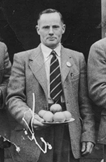
Thomas Purse
With the Norton Court Estate being auctioned off in 1952 it is likely that Thomas Purse was the last occupant who lived here due to his employment. In August 1962 Mr Purse was head gardener to Lord Redesdale at Burford, Oxon, when he returned here to judge the entries at the Norton, Leigh and District Horticultural Show.
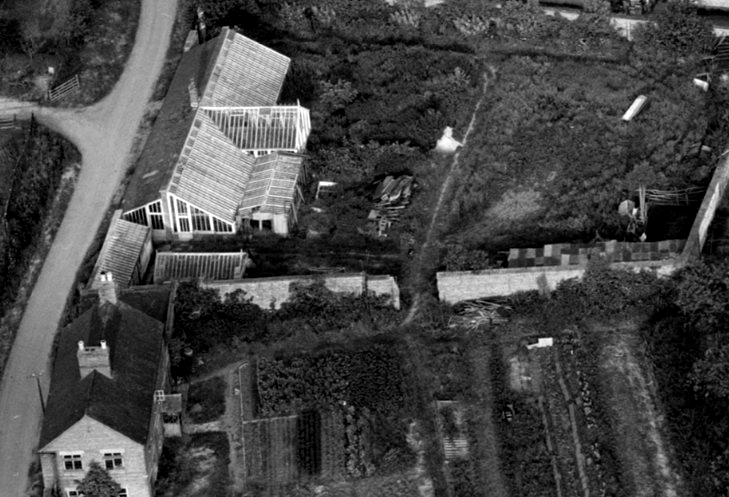
[1957]
The Norton Court Estate was sold at auction in June 1952 at which time the gardener's cottage was described as being built of brick with a tiled roof and containing; "A small hall, three sitting rooms, scullery with sink (c), and draining board, and dresser larder, cupboard under stairs and three bedrooms, one having a fireplace and two having cupboards. Concreted yard containing wc and a combined wash and coal house with furnace. Galvanised soft water tank. Attached to this cottage is a three roomed building at present used for storing purposes but without much expense could be added to the Cottage. The water and drainage ... are connected to the systems used by the Residence".
The auction catalogue also details the gardens and greenhouses adjacent to the cottage; "The two kitchen gardens, one walled in, the other partly walled, contain eight asparagus beds, an assortment of soft fruits, bush, standard and espalier fruit trees. Part of the borders adjoining then graveled paths are planted with a good assortment of herbaceous plants. There are two wells and pumps in addition to the service supplying the residence which is laid on to part of the gardens". "The greenhouses comprise, in the walled-in garden, two heated Vineries with 10 vines, Conservatory and pump, lean-to Peach House, span roof heated Melon House, a concrete built pit with 7 lights and a lean-to partitioned tomato house. The stone flower troughs, wood frames and lights, and the poultry houses are not included in the sale. The stoke-hole with new Boiler and potting shed adjoins the Vinery. In the partly walled-in garden is an old lean-to tomato house and fruit room, and near to it are a concrete built frame with 12 lights and a brick built incinerator".
From 1953 Tony and Margaret Rodman were living at The Gardens. Tony Ernest Stanley Rodman was born at Gloucester in 1926, son of Ernest and Gladys Rodman, and was living with his parents at Ernglatone, Tewkesbury Road, Norton, when he married Margaret Snow at St Mary’s, Norton, in 1953. Tony died in 1994 and Margaret continued to live here.
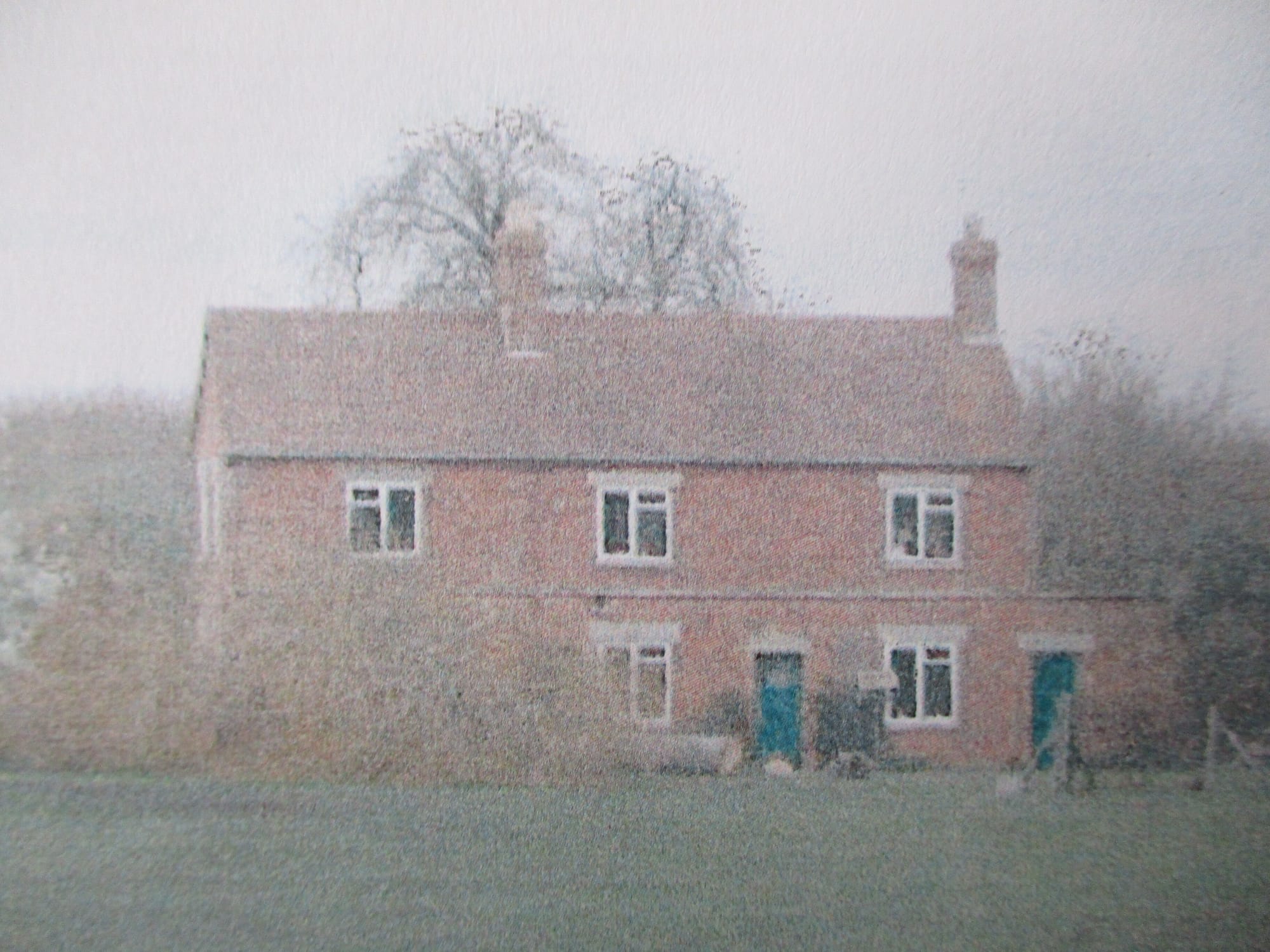
[2002]
Margaret Rodman swapped cottages with her son Ian and his wife Deborah who had been living at Orchard Cottage, almost next door, prior to 2013.
